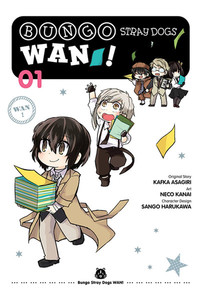Review
by Rebecca Silverman,Bungō Stray Dogs: Woof!
GN 1
| Synopsis: |  |
||
What do the members of the Armed Detective Agency and the Port Mafia do when they're not on the case? Try to solve the mystery of what everyone keeps in their lockers, play telephone with grocery lists, and tease Chuuya about his height and taste in hats, of course – along with other silly mini-adventures in this goofy spin-off of Bungo Stray Dogs. |
|||
| Review: | |||
In case you hadn't noticed, the main story, both in manga and novels, of Kafka Asagiri and Sango Harukawa's Bungō Stray Dogs is really very dark. It has its lighter moments, but everything tends to be in service of a greater, more serious theme, and that can weigh you down as a reader at times. That's where Bungo Stray Dogs Wan! comes in. A series of mini-adventures starring the cast of the main series, it goes between four-panel comics and longer format storytelling as it gives us the lighter, sillier side of what the characters get up to when they're not out saving or destroying Yokohama, and while not all light-hearted spin-offs of serious stories work, this one largely does. One of the best elements of the book is that it gives more of a focus on characters who don't get a lot of screen time in the main story. Viewers of the anime adaptation know that Kenji is one of the characters to benefit from this, and while this first manga volume doesn't spend quite as much time on him as the anime (after reading this, there's a real sense that the anime cherry-picked chapters from the entire series to adapt), getting to see him do more still feels like a treat, especially as it's revealed that his main emotion after “cheerily good-natured” is “hangry.” On the Port Mafia side, Kajii (the lemon guy) gets the most attention among the oft-neglected characters, with Chuuya and Dazai naturally playing off of each other in a less bloodthirsty way backing all of this up. With that last pairing, it's interesting to see them interacting much more amiably, as it gives us some insight into how they may have worked together back in the old days; if you've read the novel about their meeting, this depiction of them, although goofy, does feel impressively natural based on that book. That ability to rely on the main series' character dynamics and keep them recognizable here in the parody is one of the major triumphs of wan as a spin-off. For a parody to be successful, we need to be able to fully recognize the characters and atmosphere of the original work within the humor, and this does that admirably. While it does rely a bit too heavily on the “humorously suicidal” aspect of Dazai, which doesn't always work, most of the other aspects are pretty spot-on, especially Ranpo's off-beat personality and Kunikida's extreme organization skills. Both of these are perhaps best seen in the chapter where Dazai and Atsushi are cleaning the agency and Dazai decides that this is the perfect moment to see what's in everyone's lockers; Kunikida's three calendars and Ranpo's creative use of his space absolutely sum up who they are. Although Kenji's locker cow from the anime version doesn't make an appearance in this chapter, a later one in the book does give us her origin story, which is nearly as good; Yosano is in need of some blank charts and scrubs for the clinic and the list goes horribly wrong as various members of the agency keep passing it off to someone else. On the Port Mafia side, Kajii's attempt to fight the agency goes awry when Dazai learns to use stickers to his advantage, which turns out to be quite a good visual gag. We don't see as much of the mafia as we do the detectives, but their appearances are used well, particularly the near-silent appearances of Akutagawa. He's definitely one of those characters you really don't expect to see in the chibi art style of the manga, and that alone makes each creepy-eyed entry on the scene inherently entertaining. His part in the flower-viewing scene is especially good, although the entirety of the daycare chapter is a winner. While we don't see much of the Guild, they do get their own chapter towards the end of the book with Mark Twain narrating, and F. Scott Fitzgerald makes a cameo in the Cinderella chapter. Bungo Stray Dogs Wan! is, by and large, a very fun spin-off in its first volume. It isn't always laugh-out-loud, but it's almost always got a chuckle in store, and if the anime was in fact picking the best chapters, there should be some good ones to look forward to in future volumes. Not all parody spin-offs work out, but this one knows its source material well enough that it really does a good job of making fun of it. If you enjoy the main story, this is worth checking out. |
| Grade: | |||
|
Overall : B
Story : B
Art : B+
+ Good use of the source material for parodies, background characters get more page time. |
|||
| discuss this in the forum (1 post) | | |||
| Production Info: | ||
|
Full encyclopedia details about |
||